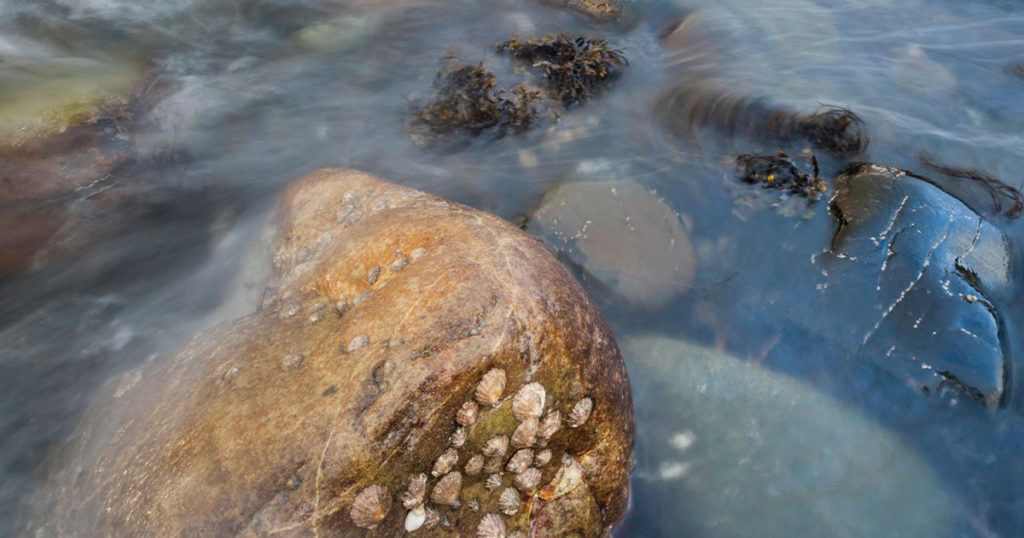
Life Between the Tides by Adam Nicolson; Farrar, Straus and Giroux, 384 pp., $30
On an early December night last year, my husband, my two daughters, and I suited up in all of our warmest clothes, grabbed headlamps, and drove to the beach. With temperatures in the single digits, it might have been nice to stay home and light a fire in the wood stove. But we felt pulled to the shore.
There was to be an extreme low tide that night—minus five feet—one of the lowest of the year. On these sorts of tides, three stories of water flush in and out of Kachemak Bay in south-central Alaska twice a day. As the water ebbs, the retreating tide exposes an enormous expanse of sea floor, revealing an otherwise hidden world trapped in the pockets of water left among the rocks. In the beams of our headlamps, we hoped to see brilliantly colored anemones, spiny sea urchins, crabs of all kinds, and if we were lucky, perhaps even a shy octopus. How could we stay away?
I’m fairly certain that Adam Nicolson, a prolific writer of history, natural history, and literature, would have done the same. In Life Between the Tides, he is a limpet glued to the rocky intertidal of a wild, windswept coast of western Scotland, about 70 miles northwest of Glasgow. It seems there’s nothing that can tear him away.
The intertidal is the zone of shoreline between high and low tides. And it is a world of extremes. As the tide comes and goes, the intertidal is sometimes drowned by the sea, sometimes parched. When exposed to the air, it can be baked by the sun or gripped by freezing temperatures. Sometimes it’s throttled by waves, other times slapped by the wind.
These extreme conditions make for assemblages of curious creatures that have figured out how to survive there. Nicolson delights in exploring the myriad ways they protect themselves from the challenges of this habitat. Some, for example, wear hard shells and glom tightly onto rocks. Others use camouflage, play dead, scatter maniacally, or slither into hidden crevices.
Nicolson also shows us that in many ways, these alien creatures—animals with eyes on stalks, organisms that are spineless but have scores of legs or that have no discernible body parts at all—are, in fact, much like us. Shrimplike sandhoppers, he writes, inherit an internal compass from their parents. Crustaceans can feel anxious—and, experiments have shown, can be helped by anti-anxiety drugs. Perhaps none of this should be surprising: the British government recently recognized lobsters, crabs, octopuses, and related species as sentient beings and is including them in the country’s Animal Welfare Act.
Nicolson’s book plumbs the natural history and meanings of this zone of ocean flux—what he calls “one of the most revelatory habitats on earth.” Before written words even existed, the rhythms and metaphors of the sea and tides governed life—from menstrual cycles to planting calendars. In literature, the ocean’s edge is a magical place of fairies, talking birds, and beasts part human, part animal. And for millennia, the shore has been a place of survival. A traditional saying among Indigenous peoples of the Pacific Northwest is, “When the tide is out, the table is set.” The exposed sea floor makes for abundant eating worldwide; ancient shell middens confirm this. But the intertidal has also been a troubled place: in centuries past, it was the burial site of the disgraced.
Much modern science has emerged from the intertidal, Nicolson writes. Darwin developed the theory of evolution based in part on years of studying barnacles. Important ecological concepts have surfaced from the sea’s edge as well—that of keystone species and trophic cascades, for example—critical ways of understanding the ecosystems around us and those we are altering at every turn.
Nicolson does a little science of his own. The stretch of Scottish coast where he finds himself in these pages, though filigreed with lochs, is disappointingly devoid of tide pools. So he set about constructing some of his own, first using only nearby rocks, and then bringing in concrete, working during the limited hours when the tide was out. He recounts the thrill of seeing shrimp in his manmade tide pool for the first time, on a low tide under the light of the moon. “It felt like a sort of de-extinction,” he writes. “I had made a place where life was welcome.”
Life Between the Tides is richly associative, perhaps because Nicolson has words and the sea in his blood in equal measure. His father was the writer Nigel Nicolson, his paternal grandmother, the writer Vita Sackville-West—who was also, famously, Virginia Woolf’s lover. When he turned 21, Nicolson’s father gave him a clump of uninhabited rocky islands off the Scottish coast—the Shiants, a world of wind, waves, and nesting seabirds—where Nicolson had spent time since he was a child and took his own children as they were growing up. A previous book explored the lives of the island’s avian residents.
Life Between the Tides is testament to a life spent endlessly looking at the sea’s wild edge, making connections, and mulling over meanings. Nicolson drapes an almost exhausting body of knowledge—from Aristotle to Wordsworth—onto the shore, like the layers of kelp that at times masked what felt like the highest purpose of the book: to serve as a plea to pay attention to the damp, ephemeral world at the lip of our oceans. When Nicolson observes how a shrimp holds still to blend with its surroundings as his shadow crosses its pool, he writes, “It was all there in front of me, the unseen genius of the prawn body and mind revealing its layered abilities to think, evaluate and decide.” Ultimately, tide pools wash themselves of the trappings of history, philosophy, and metaphor. They become once again themselves, little pockets of the sea, a chance to observe the wonders of life and, for a moment, to feel part of it.

